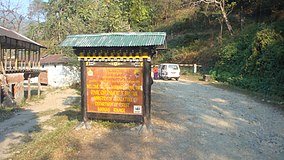Royal Manas National Park
26°53′58″N 90°45′29″E / 26.89944°N 90.75806°E
| Royal Manas National Park | |
|---|---|
 Entrance to the park | |
 Location of Royal Manas National Park in pink | |
| Location | Pemagatshel, Sarpang, Zhemgang, Bhutan |
| Area | 1,057 km2 (408 sq mi) |
| Established | 1966[1] |
| Governing body | Department of Forests and Park Services of Bhutan |
| Website | Department of Forests and Park services |
Royal Manas National Park is
It is connected via "biological corridors" to Phibsoo Wildlife Sanctuary, Jigme Singye Wangchuck National Park, Phrumsengla National Park, and Jomotsangkha Wildlife Sanctuary. Royal Manas also directly abuts the World Heritage Site Manas National Park in Assam, India, to the south. It is listed as a tentative site in Bhutan's Tentative List for UNESCO inclusion.
Entry is prohibited to the public.
History
Royal Manas was one of the earliest focuses of the Bhutan Trust Fund in the early 1990s, receiving infrastructure development and baseline biological and socio-economic assessments. Bhutan's first park management plan was prepared for Royal Manas, and guided management of other parks.[2]
Natural history
Flora
Habitats in Royal Manas National Park range from lowland tropical forests to permanent ice fields. Ecoregions in the park include Eastern Himalayan broadleaf forests and Himalayan subtropical pine forests.
Royal Manas also produces several plant species used in food, commerce, medicine, and religious rituals. About 5,000 people live in remote, isolated villages within the park.[2][1]
Fauna
Royal Manas National Park is home to
The Manas River and its tributaries are home to three species of rare migratory game fish called mahseer: the deep-bodied mahseer (Tor tor), golden mahseer (Tor putitora), and chocolate mahseer or Katle (Acrossocheilus hexangonolepis).
See also
- List of the national parks of Bhutan
- List of protected areas of Bhutan
- Manas National Park — adjacent in Assam, India.
References
- ^ a b "Royal Manas National Park". Himalaya 2000 online. Bhutan Travel Guide. Retrieved 2011-04-02.
- ^ a b "Parks of Bhutan". Bhutan Trust Fund for Environmental Conservation online. Bhutan Trust Fund. Archived from the original on 2011-07-02. Retrieved 2011-03-26.

